Google Shopping has some of the highest potential to generate massive sales. We’re not kidding.
In fact, for most retailers, Google's ad network is the sweet spot for PPC shopping ads. In a recent study, 98% of people surveyed worldwide reported that they shop online. Among the ads they’re clicking, 85.3% of all those clicks happen on Google Shopping ads.
And investment in Google Shopping ads is only growing year-over-year.
So, if you’re in the eCommerce space but not using Google Shopping ads yet, you’re missing out on a vast network of conversion growth opportunities.
*FOMO intensifies*
If you haven’t ventured into Google Shopping yet because setting up campaigns feels daunting between the Merchant Center, feed setup, and campaign build, not to worry. That’s what we’re here for.
In this article, we’ll cover the A–to–Z checklist of setting up your Google Shopping campaigns so you can get a complete bird’s eye view of the entire process.
Not only that, but once you’ve built your Google Shopping setup chops, you’ll get access to a detailed checklist of campaign optimizations you can use to keep your campaigns in tip-top shape.
- What are Google Shopping campaigns?
- A complete checklist: How to set up a Google Shopping campaign
- 1. Set up your Google Merchant Center account
- 2. Create and connect your Google product feed
- 3. Set your product listings up for success
- 4. Build your Google Shopping campaigns
- 5. Add remarketing lists to your campaigns (two techniques)
- Google Shopping campaign optimization checklist
- Wrapping up on Google Shopping campaigns
Get brand new Google ad strategies straight to your inbox every week. 23,739 people already are!
What are Google Shopping campaigns?
Google Shopping campaigns are a type of campaign on Google Ads (formerly Google Adwords) that allow you to show ads displaying your product images and pricing. Your Shopping ads can also show current discounts or promos (like free shipping).
Searchers can see all this info about your products from the top of the search engine results page (SERP) before ever visiting your website.
Google Shopping is available to advertisers in these countries with physical products for sale.
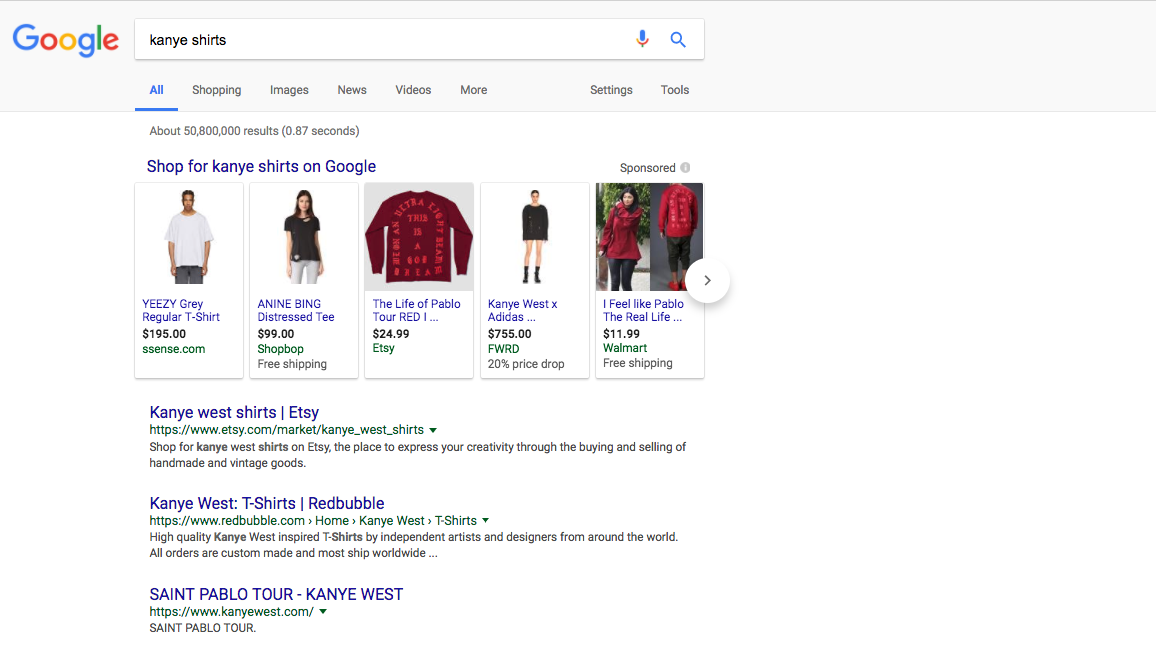
Because shopping ads convey so much more information to the searcher before they visit your site, the clicks they bring in tend to be from visitors with stronger intent to buy.
In other words, you end up with visitors who already know what your product looks like and how much it costs. Heck, they might even be ready to add it to their cart.
With that in mind, it’s no wonder that Google Shopping spend grew by 41 percent from the prior year over text ads in Q1 of 2019.
How do Google Shopping campaigns work?
It can be tempting to think that Google Shopping campaigns work the same as normal keyword-based Google Ads campaigns, serving your product listings based on the keywords in your ad groups. Actually, that’s not the case.
Google shopping has zero keyword targeting capabilities.
Your Google shopping campaigns are instead powered by a product feed housed within the Google Merchant Center. So, yes, you’ll need to set up yet another account with Google. But that’s okay—we’ll briefly go over how to do that in a bit.
With no keywords in your ad groups, Google will serve ads based on your entire product catalog. The only controls you can exert over this are through product groupings or SPAGs (single product ad groups).
What’s the difference between paid and free Google Shopping listings?
Not all Google Shopping listings you see are paid ads. In fact, a good amount of them are free, organic listings.
If you already have your Merchant Center feed set up correctly, you can qualify for organic listings by opting in (or checking if you are already opted-in) to “Surfaces across Google” within your Merchant Center account.
The main difference between paid Google Shopping ads and free Google Shopping ads is control.
With free listings, you don’t get to control where your ad shows or how competitive it is against other Shopping listings.
As far as page position, free listings always play second banana to the paid listings. Paid listings take the top spots (naturally) and are in a more organized format that makes it easier to see many options at a glance.
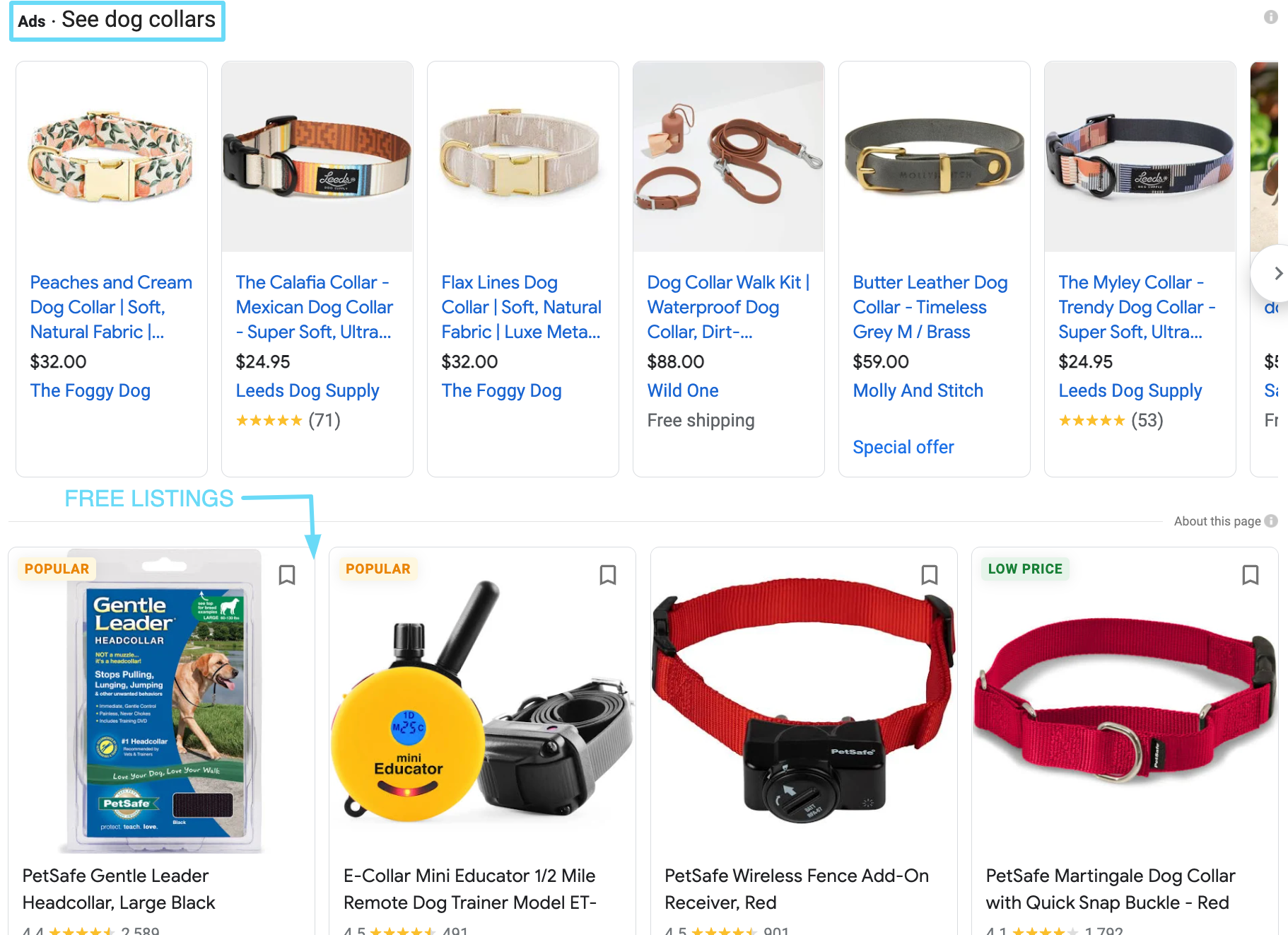
With paid Shopping ads, you can control how much you bid on different product groups or individual products. And, as we see in the screenshot above, they get placements at the top of the results. Both of these advantages greatly improve your chances for more clicks and sales.
So, while getting a bit of free “air time” for your products from Google is nice, it’s still no substitute for a paid Shopping ad when it comes to reeling in the profit.
A complete checklist: How to set up a Google Shopping campaign
If you’re just starting out with Google Shopping, it can be challenging to understand the relationship between your Google Merchant Center account, Google Ads account, product feed, and campaigns.
What do you set up first? How does one connect to the other? How do your campaigns function based on that information?
Although this article discusses the setup of Google Shopping campaigns within Google Ads, that part can’t happen until you’ve cleared some preliminary setup hurdles.
So that’s why we’re giving you a checklist that starts before the creation of the campaign itself in Google Ads—to organize the process, and help you conquer all these setup hurdles in the right order.
Let’s get straight to it.
1. Set up your Google Merchant Center account
Your Google Merchant Center is the powerhouse for all of your product data. On the home page, you’ll find an overview of the general health of approved and disapproved products, paid clicks, and general updates:
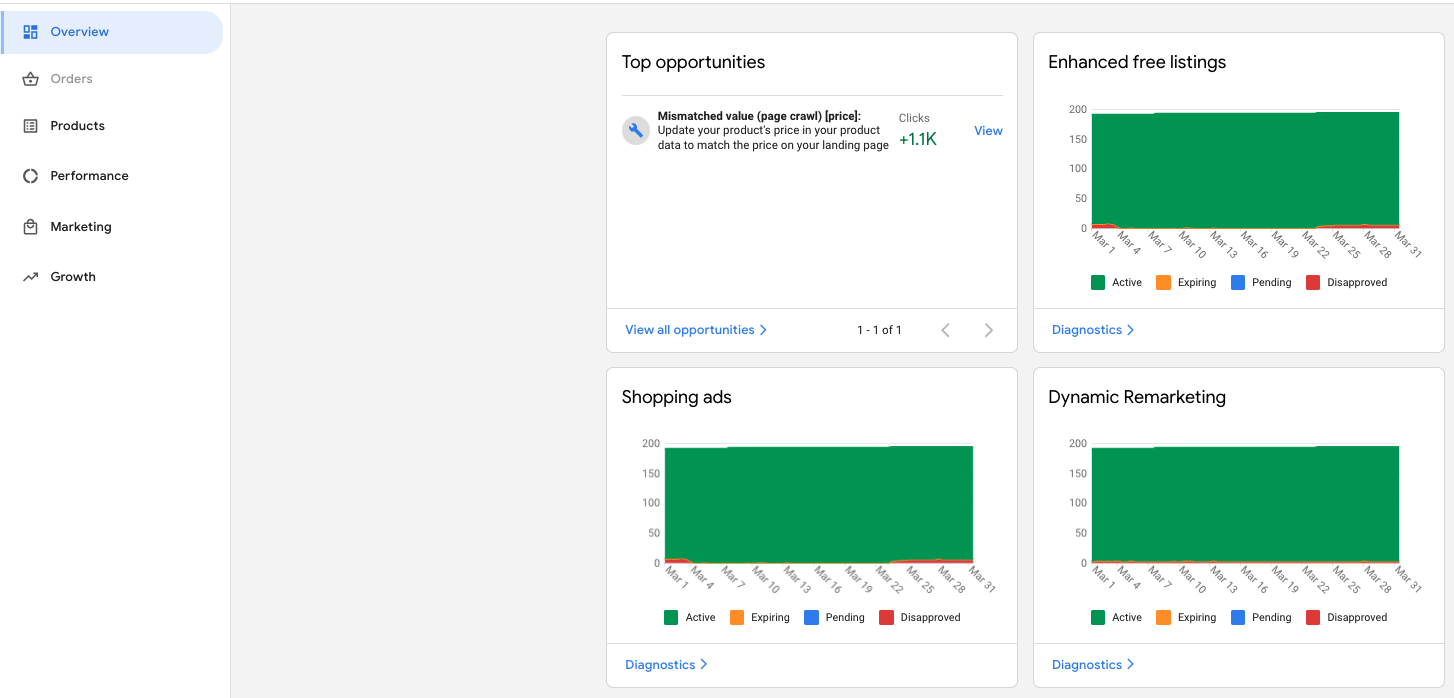
To set up your account, the first thing you’ll need to do is update your business information. This includes basic things like how you want the name of your business to be displayed, your website, physical address, and account users.
After that, you’ll need to
- claim and verify your website URL
- meet the Merchant Center guidelines
- set your tax and shipping settings
You’ll need to at least link your Google Merchant Center account to your Google Ads account to bring your product feeds into Google Ads.
For a more in-depth look at setting up and linking Google Merchant Center to your Google Ads account and other Google products, take a look at this article.
Once all your initial Merchant Center steps are taken care of, you’re now ready to head into the heart of setting up Google Shopping: establishing your product feed.
2. Create and connect your Google product feed
Hang in there; we’re finally getting to the fun part.
Before you can start making exciting, data-driven adjustments to your product feed and campaigns, you first need to create a product feed that meets all of Google’s requirements. This is because Google uses your product feed to match your ads to people’s search queries.
First, meet Google’s feed requirements
Google’s requirements for your product feed will depend on the kinds of products you sell, but there are a few universal details that Google requires for every feed:
- ID: a unique identifier for all of your products
- title: your product’s name
- description: a description of your product
- link: the link to the exact product landing page (not product category page nor homepage)
- image link: a link to a clear image of the product you’re selling
- availability: whether your product is in stock, out of stock, or on pre-order
- price
- shipping cost
- tax (U.S. only)
- condition: whether your product is new, used, or refurbished
- adult: Whether or not you are selling an adult product
Next, if you sell anything other than books, music, and movies, Google has some additional fields that you’ll need to include in your feed, such as
- your product’s brand name
- GTIN: if your product has an assigned Global Trade Item Number assigned by the original manufacturer
- MPN: if your new product does not have a manufacturer-assigned GTIN (one exception is if you’re selling custom or handmade goods; in this case, you wouldn’t have an MPN or GTIN)
- multipack: if you’re selling a group of individual products as a single unit, like a 6-pack of scented candles
- age group: required for clothing items
- gender: required for clothing items and any other gender-specific products
- size: required for clothing items
- pattern: if relevant for distinguishing different products in a set of variants
- material: if relevant for distinguishing different products in a set of variants
- item group ID: required for products that are variants of each other, like different sizes of the same kind of shoe or different colors of a basic t-shirt
Now that you know the specifications that will be required in your product feed, the last thing you need to do is ensure that your product data has a way of making it to your Google Merchant Center account.
Upload and submit your product feed
Google gives you a few ways you can upload products to your Google Merchant Center account. The option you choose will most likely depend on the number of products you sell, how often your inventory is updated, and IT resources available to you.
The simplest option that Google gives you is to register a Google Sheet on Google Merchant Center. You can set this up by going to your Merchant Center account, going to the products menu, and adding a new feed:
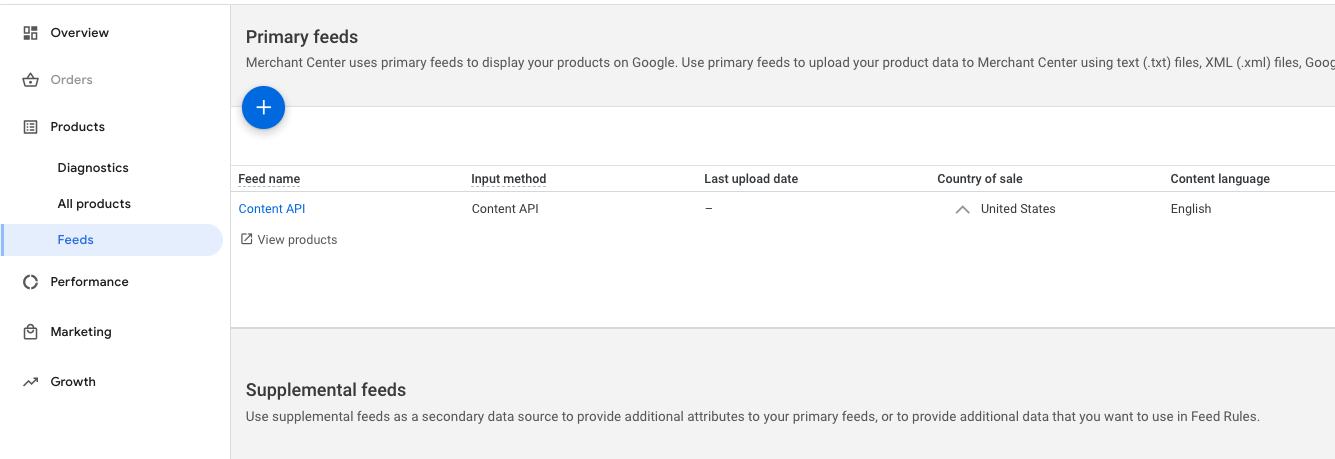
After you click the plus sign, you’ll be asked to specify your target country and destination:
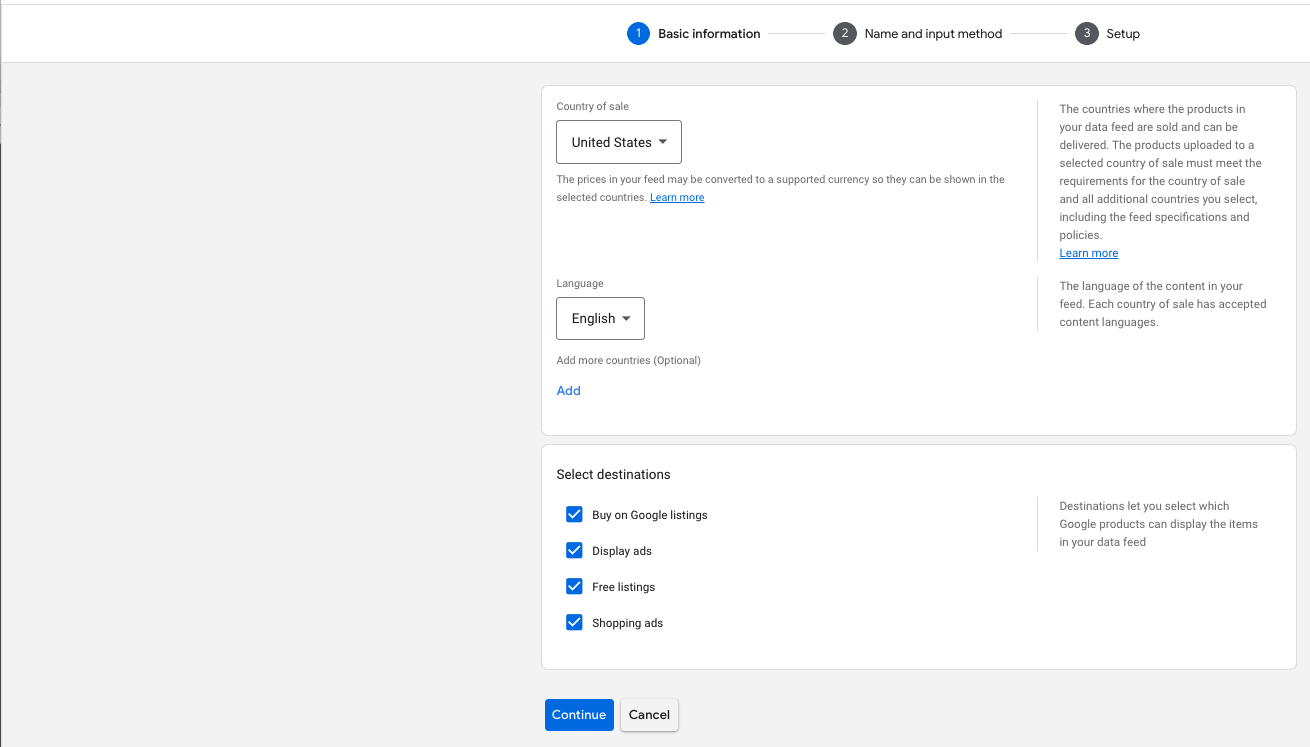
Next, you’ll have to specify what kind of feed you want to create. One of those options is to use a Google Sheet.
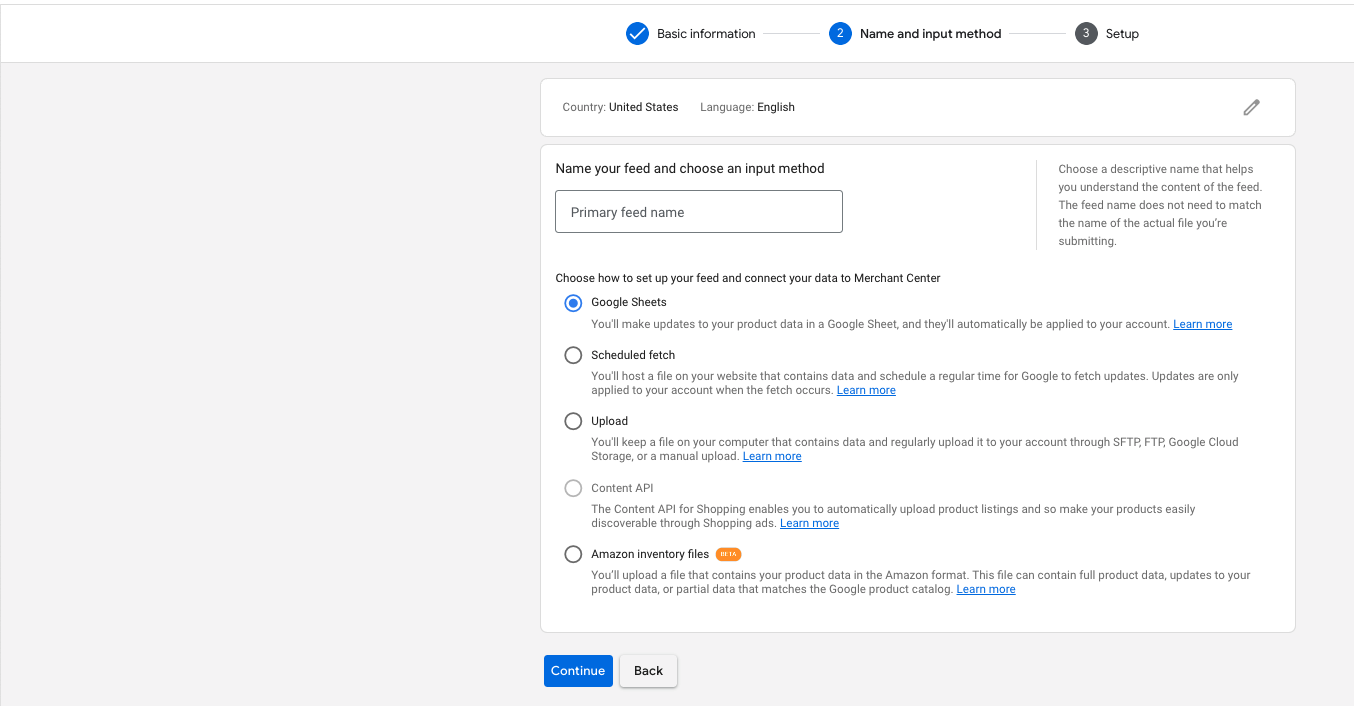
Last, you get the option of whether you want the Merchant Center to hook you up with a product template or select an existing Google Sheet.
Selecting a product template is especially helpful for getting the correct formatting on your Google Sheet, which ensures your feed and products will upload correctly. But if you decide to use an existing Google Sheet, you may want to spot-check your format with the template.
You can also choose to create an upload schedule so that your product data can be automatically refreshed:
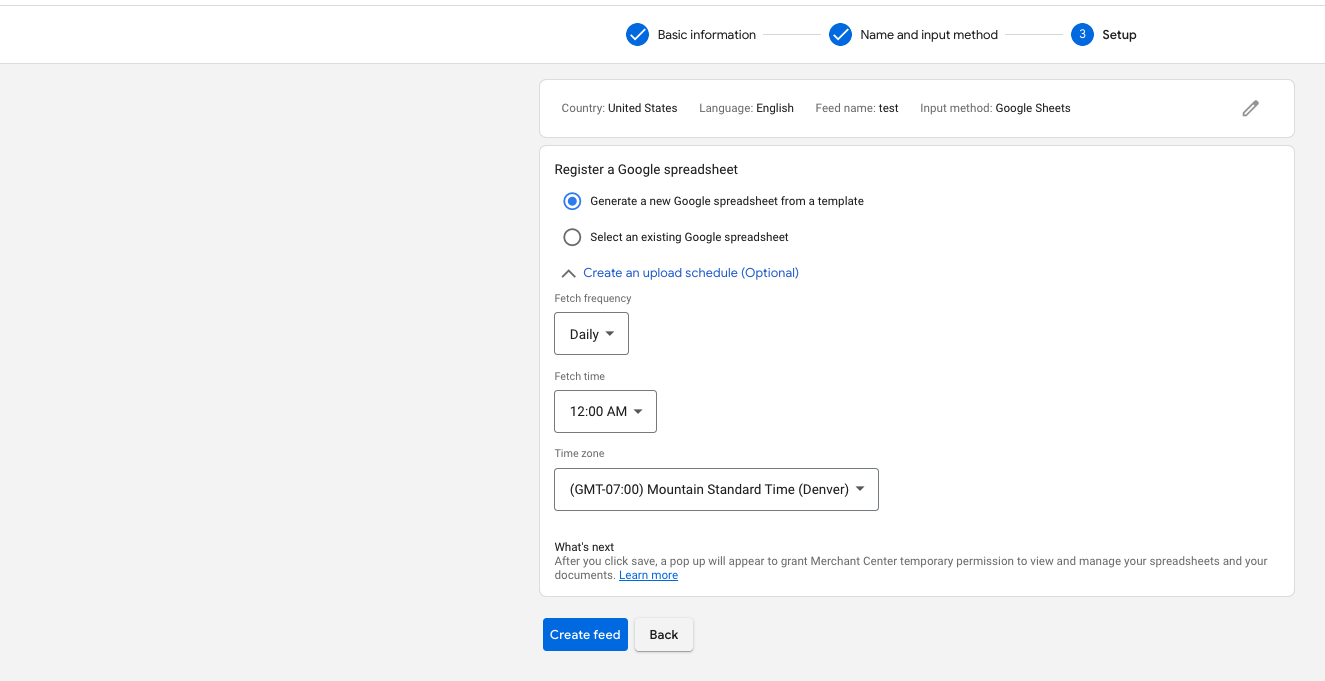
I recommend checking the option to create an upload schedule because Google requires your full product feed to be submitted at least every 30 days, even if your inventory doesn’t change that often. If your inventory changes a lot, Google allows you to upload your full feed up to four times a day.
If you’ve been following these steps, you should now be in front of a cool Google Sheet with columns for all the product data fields you may need.
For an easier time filling in all this data, you can download a CSV from your online shopping cart platform. You can also use feed rules.
Apply feed rules to meet Merchant Center requirements sooner
The Google Merchant Center also gives you an extra option to help speed up your way to a complete, accurate product feed: Feed rules.
To get to these, go to the products menu and select “Feeds.” Then, click on one of your active feeds, and go to “Rules.”
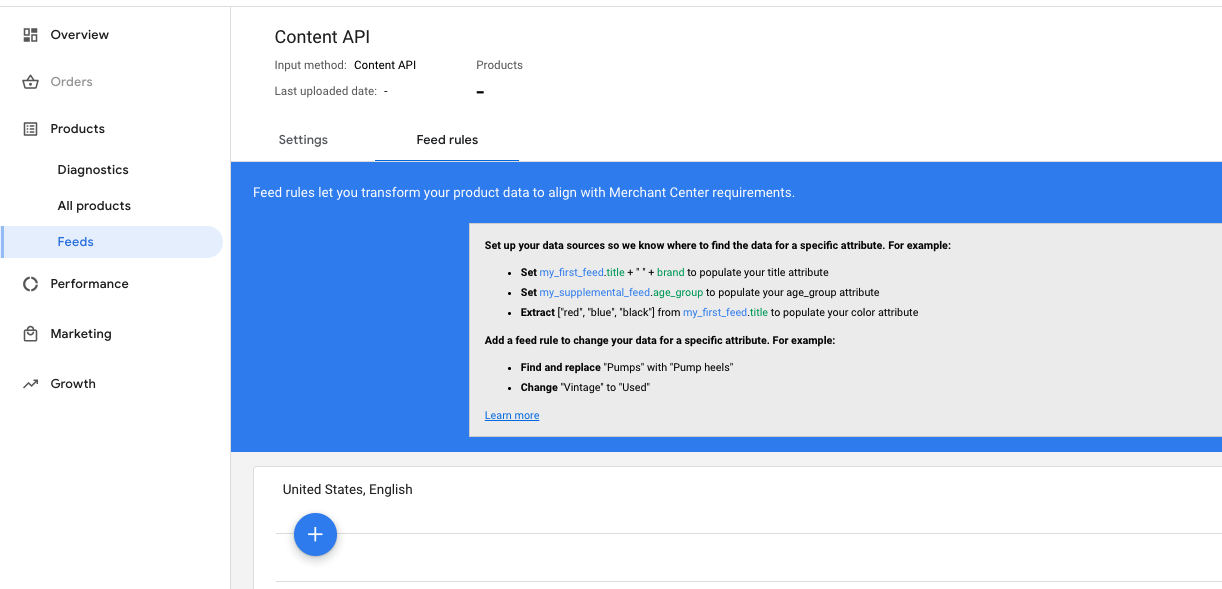
You can use feed rules to designate these kinds of attributes:
- constants (applying a static value to a group of items)
- mapping and assigning existing attributes in your feed
- attributes from a supplemental feed
So, let’s go over a few ways you can apply feed rules to actually improve your product feed and Google Shopping campaigns.
A. Use feed rules to fill in missing data requirements in your product feed. For example, if I were missing a required attribute like “brand,” I could create a rule to set the brand as a static value whenever it’s missing (if my store only carries one brand). Or, I could map to another attribute in the dropdown.

B. Use feed rules to create custom data columns. This will allow you to have more granular campaign segmentation.
C. Assign common products together based on an existing attribute in your feed. This can help you filter out groups of products from your feed (if needed) using the common identifier you give them.
D. Populate the promotion ID field with a static value. This can help improve the speed at which your promotions are rolled out.
Now that we’ve covered the basics of setting up your Google Merchant Center account and submitting your product feed, let’s talk about taking your product data from good to great with some product feed optimization strategies.
3. Set your product listings up for success
For your Google Shopping campaigns to be successful, you need to have product listings that hit a home run. You want your products to give your buyers as much relevant information as possible.
Why? Because if your product checks all their boxes at a glance and doesn’t leave them guessing, they’ll be more inclined to click and possibly purchase.
That said, one of the most vital pieces of your product listings (that conveys exactly what we mentioned above) is your product titles.
It’s important to write product titles that appeal to what your searchers are looking for to keep their attention. And it’s equally important to write product titles that trigger Google to show your listings for the right searches.
Though these may not apply to you, there are a lot of recommended ways of writing product titles, such as
- <brand> <category> <color>, or
- <brand> <category> <model number>
Successful search-relevant product titles depend on what kind of buyer you have (consumer or professional) and whether your brand is well-known in your space.
This matters because Google reads your product titles from left to right. This means that Google assigns more importance to words that are closer to the beginning of your product title.
Below are some of our top tips for writing killer product titles that fit your market.
A. If your brand is new or irrelevant to searchers, don’t make it the first element of your product title. Since Google prioritizes the first elements of your title, you don’t want it to focus on a keyword (like a new brand name) that won’t have much search volume or relevance. If you’re not sure how much volume your brand name keywords have, you can look them up in Google Keyword Planner.
B. If you sell products with model numbers that are relevant or likely to be searched, put those toward the front of the product title. For example, if you sell dishwashers and know your highest-intent searchers are probably commercial purchasers looking for model numbers, use a product title like “Maytag MDB8959SFZ Built‑In Dishwasher - 24" Stainless Steel, Energy Star Qualified.”
C. Leave the SKU out if it’s irrelevant. For example, if you sell clothing, it’s highly unlikely any of your consumer buyers will be searching by the SKUs of your merchandise.
D. Make your titles as relevant to higher-intent queries as possible. Someone searching for “sweaters” doesn’t have the same buying intent as someone searching for “J. Crew lambswool crewneck sweater.”
Because the latter search is much closer to a sale, tailor your product titles to reap the rewards of these high-intent searches. For example, I’d write this title as “J. Crew Men’s Crewneck Sweater in Lambswool, Navy Stripe.”
E. Scan your search query reports for words and phrases (other than your brand) that lead to sales most often. Then, include those words or phrases closer to the front of your product titles.
For example, let's say the same J. Crew sweater from above was generating consistent, profitable sales from a search query like “men’s professor sweater.” We can rewrite our original product title of “J. Crew Men’s Crewneck Sweater in Lambswool, Navy Stripe” to “J. Crew Men’s Professor Sweater in Lambswool, Navy Stripe.”
4. Build your Google Shopping campaigns
Have you ever seen a Google Shopping campaign with just one ad group that contained all of the seller’s products? I have. It’s crazy how inefficient and wasteful that can be.
It’s much more beneficial for your budget and performance to use a campaign structure that’s suited to make the most of your best-selling products and search queries.
Your approach will vary based on the kind and quantity of products you sell, but let’s look at how to create a shopping campaign to begin with, plus a few of the most kick-ass shopping structures you can use.
How to create your first Google Shopping campaign
Before we delve into some of the intricacies of great Google Shopping structures, just knowing how to set up your first campaign is a good starting point.
The beginning of your new campaign setup is where you’ll establish the connection between your campaign and the Merchant Center feed you want to use. That’s what makes your campaign…well, a Shopping campaign.
Without further ado…
1. From your campaign overview, create your campaign by clicking the blue “+.”
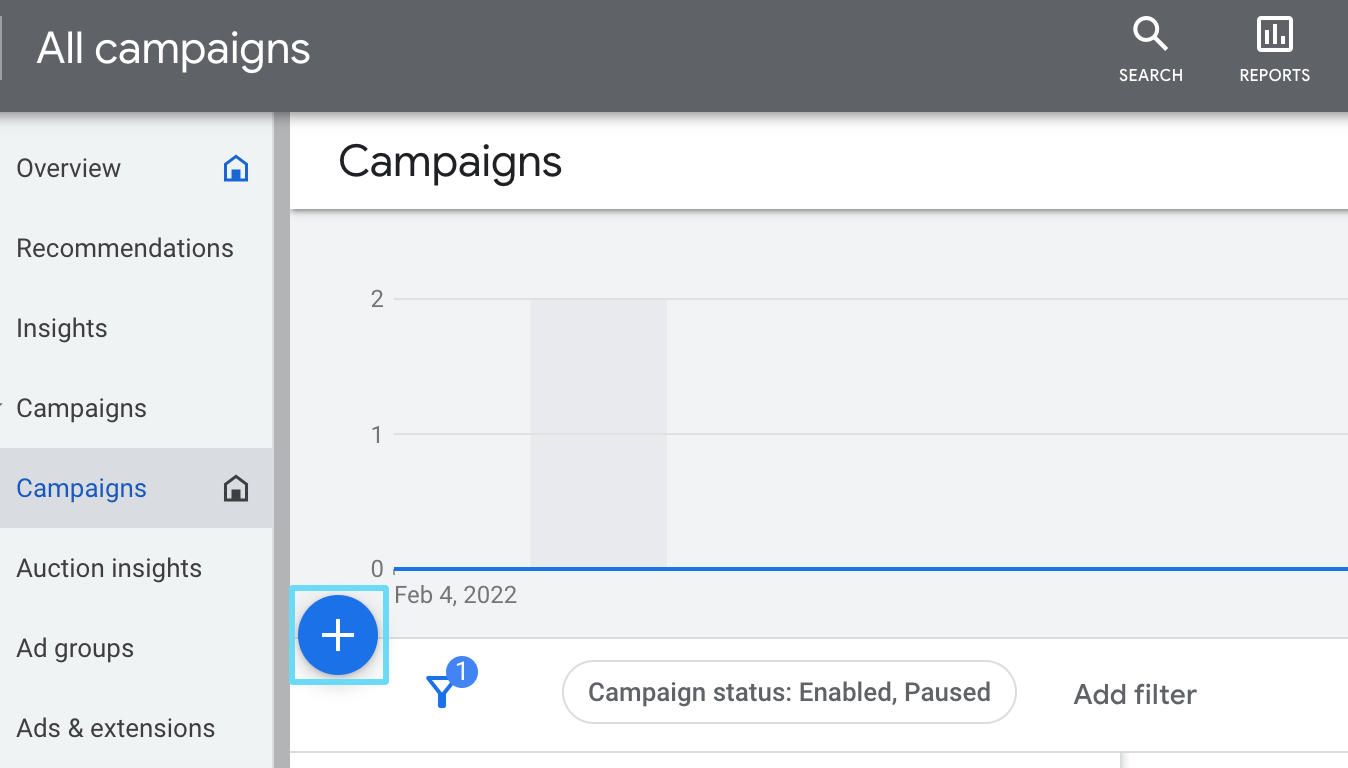
2. Select your campaign objective. For this example, I’m going to decide to create a campaign without a goal’s guidance.
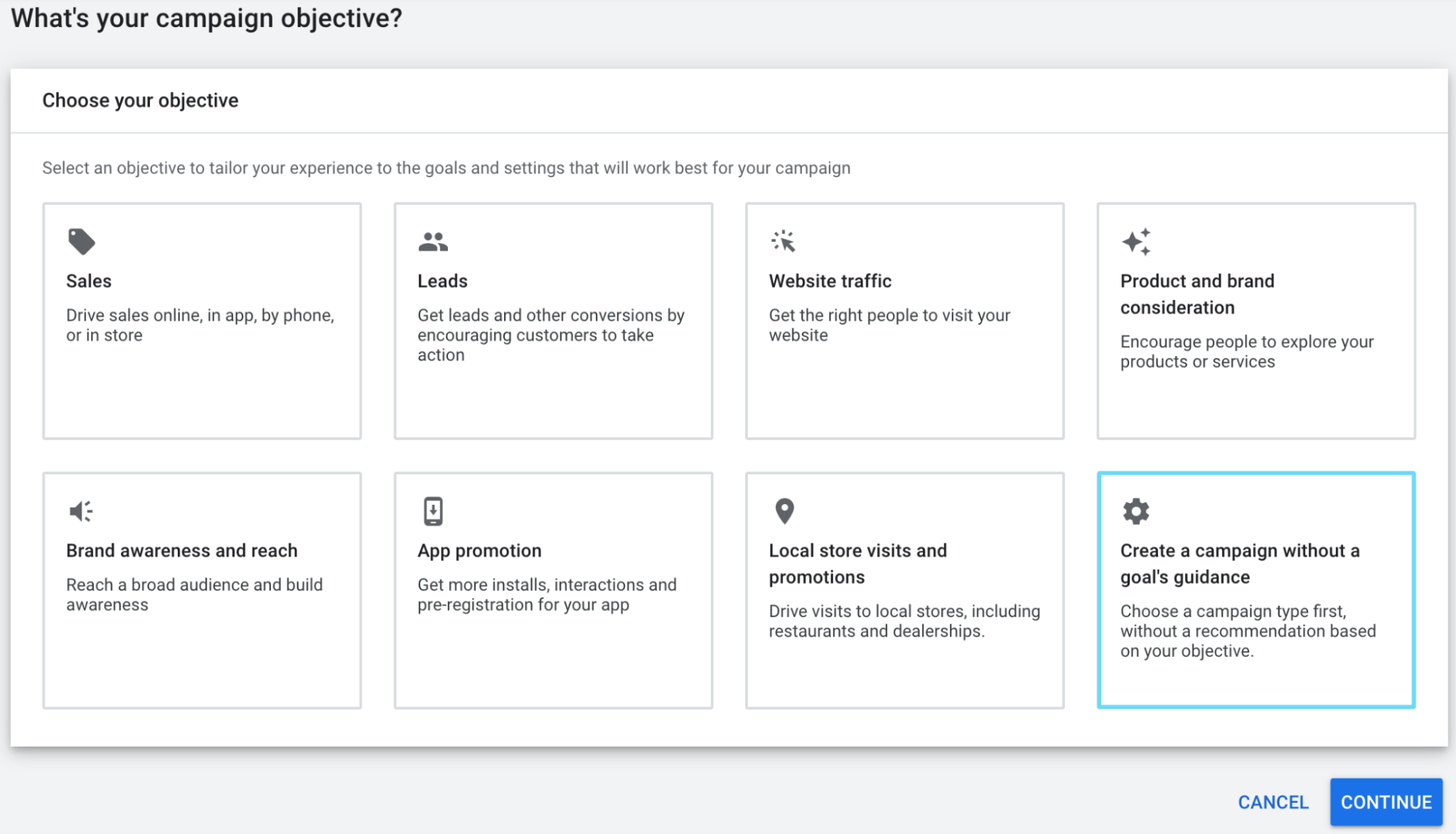
3. Select your campaign type. We’ll want to choose “Shopping.”
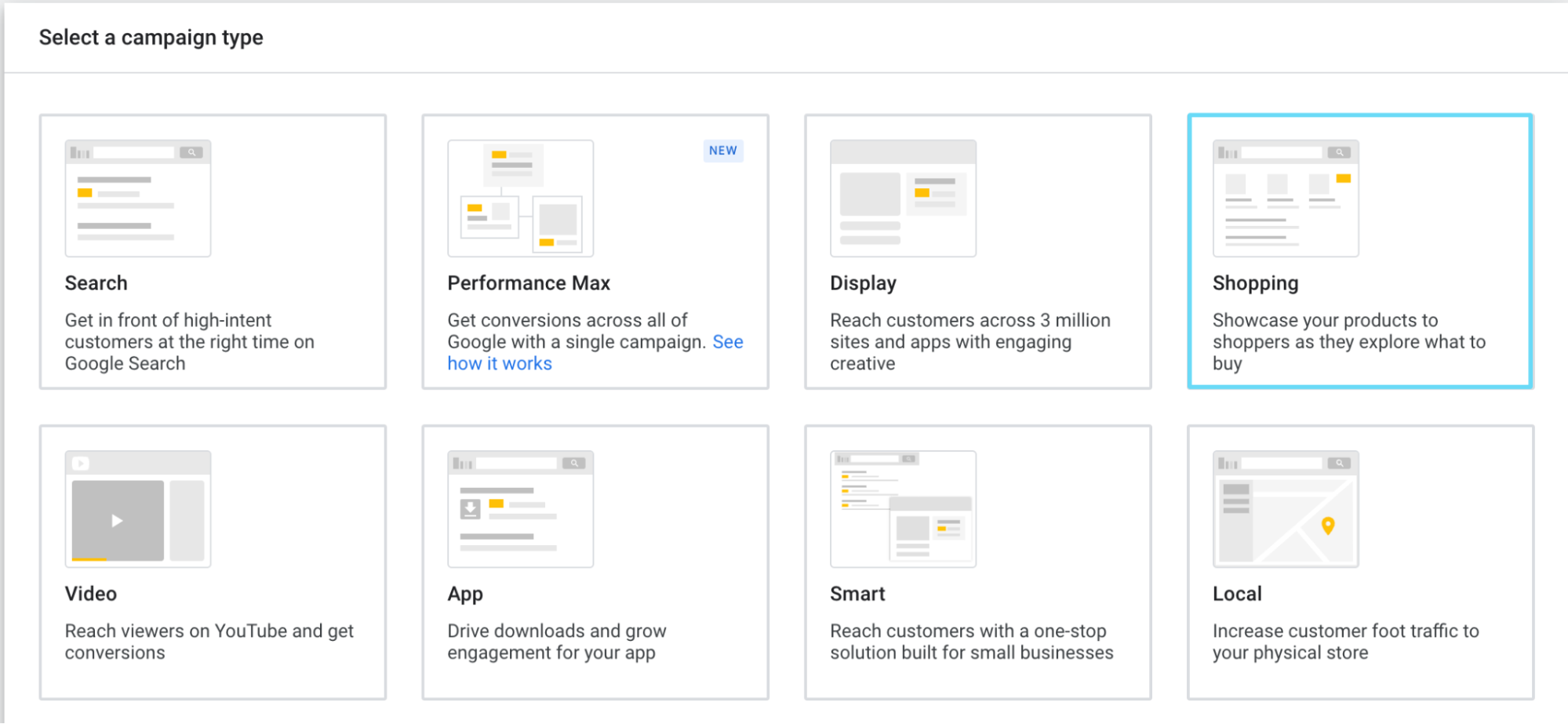
4. Choose which conversion goals you want to optimize for.

5. Select the feed you want to link your campaign to and the country of sale. (You’ll need to have already linked your Google Merchant Center account to your Google Ads account at this point.)
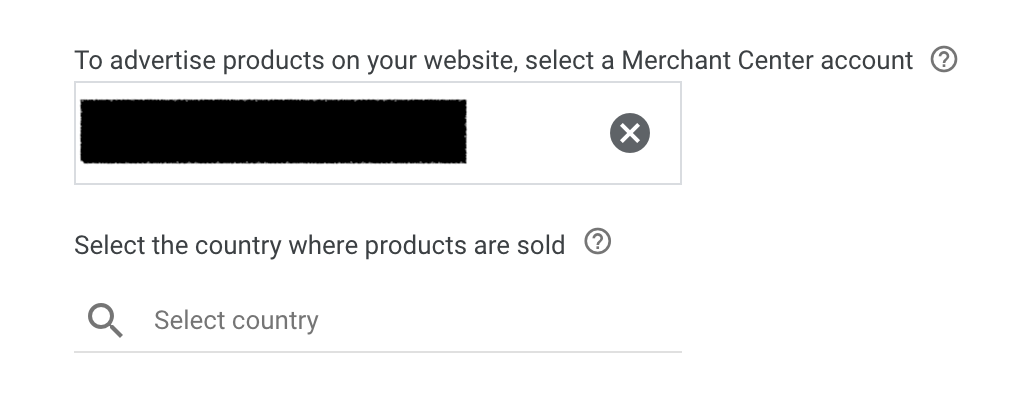
6. Select whether you want to make a Standard or Smart Shopping campaign. For now, we’ll choose standard, but if you want to learn more about Smart Shopping, head to this article. Once you’re done here, click “Continue.”

7. Name your campaign, and set up any additional settings you’d like the campaign to have. For example, you may want to apply a product filter to specify that you only want this campaign to advertise products with certain attributes.
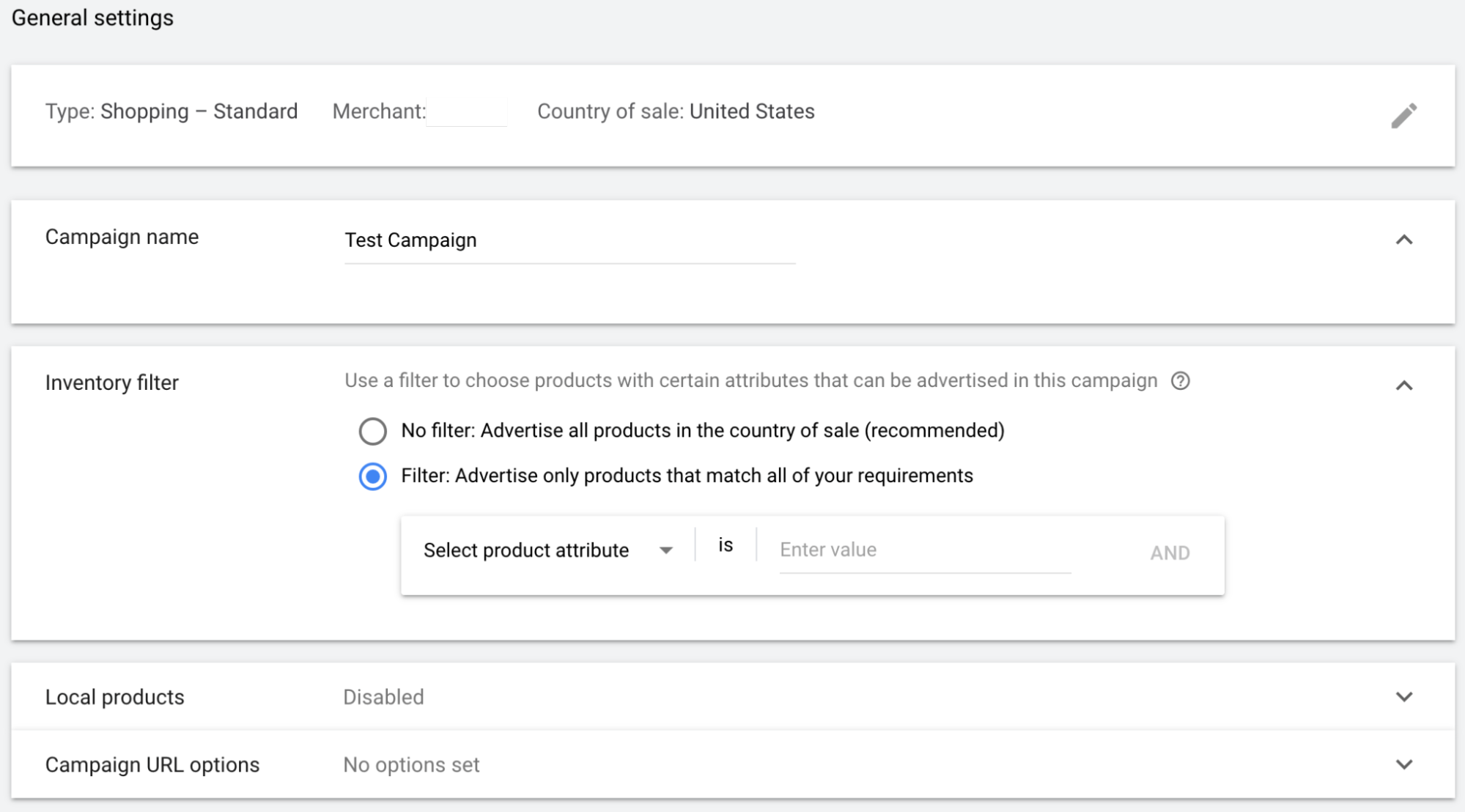
8. Set your bidding strategy and your budget. For bidding, you can use Manual CPC, Maximize Clicks, or Target ROAS. However, if you want to diversify your bids by product when creating SPAGs (more on that later), you may want to choose Manual CPC.
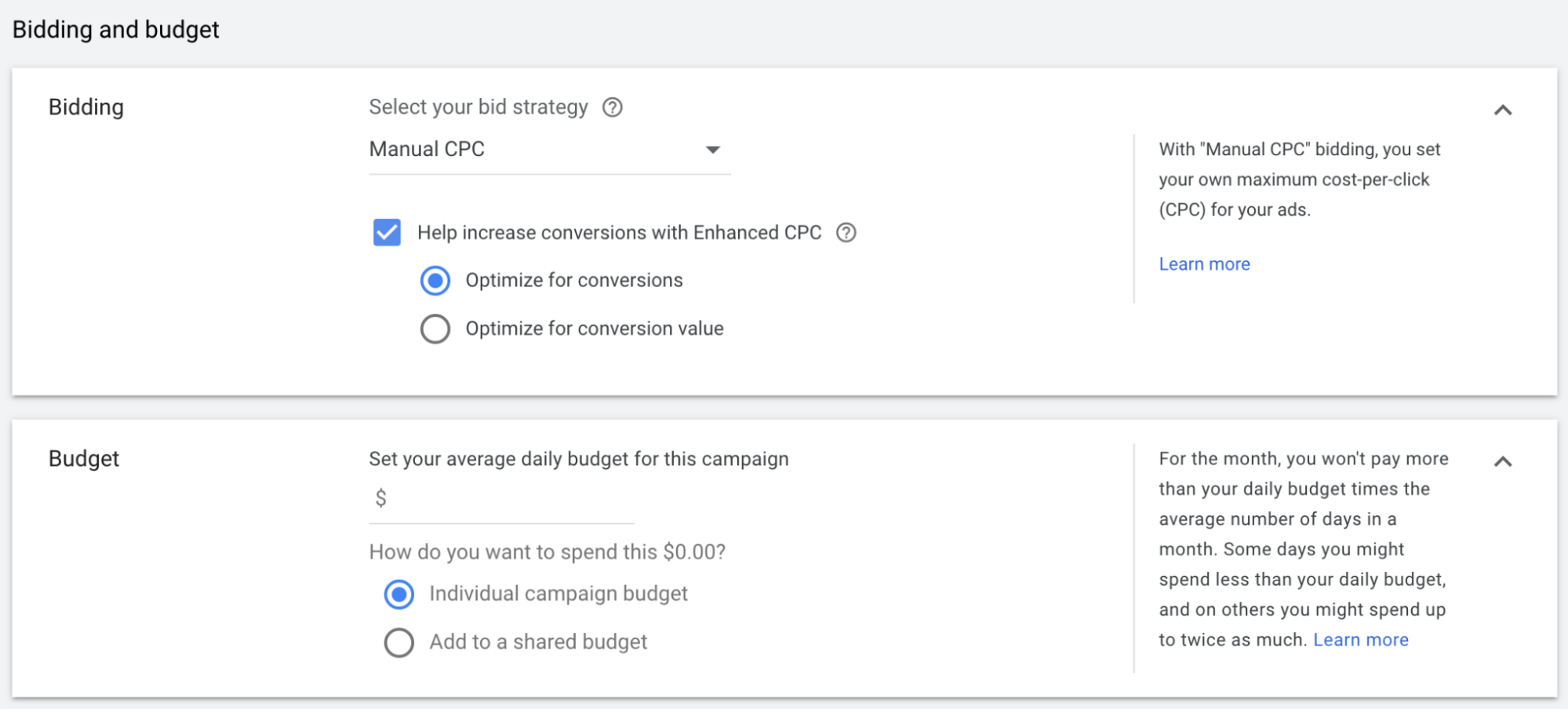
9. Choose your campaign priority. This is only important if you’ve got multiple campaigns advertising the same product. This setting just indicates which campaign should get priority bidding in the auction for that one product. Otherwise, you shouldn’t need to worry about it.

10. Choose your network, location targeting, and start and end dates (if applicable). You’ll notice that, unlike regular campaigns, your Shopping ads don’t have the option to show on the Display Network.
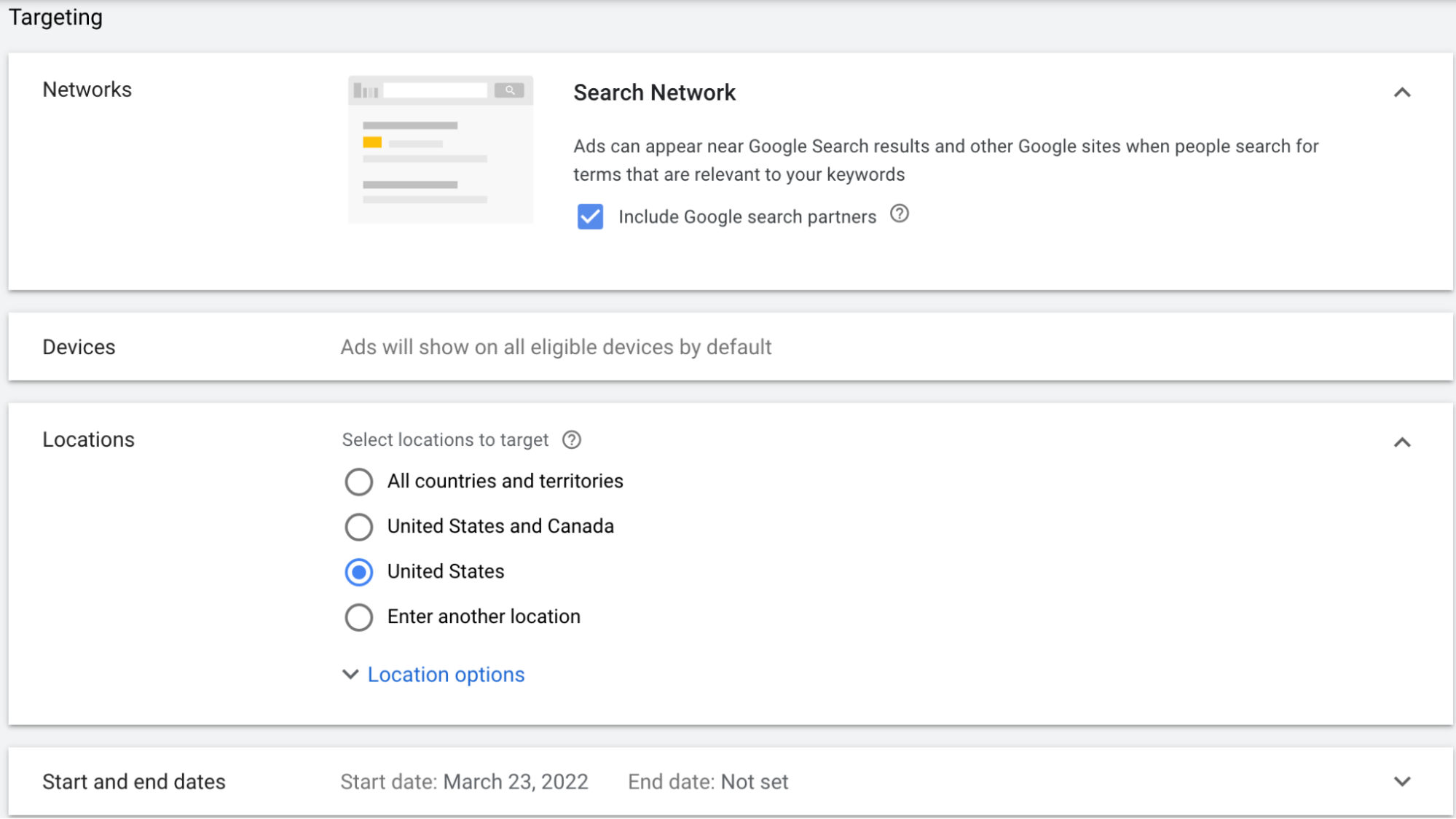
11. Name your first ad group, and set the default bid for that ad group. If this is going to be an ad group containing a product that’s more important or a higher seller, then set a higher bid.

And now, you can click “Create Campaign,” and your first Shopping campaign’s ready to go.
If you’ve ever set up a normal search campaign, you might be thinking, “That’s it? Where’s the rest?”
Remember, Shopping campaigns don’t run using keywords, and your shopping listings won’t have extensions. So as far as basic campaign setup goes, this is it, folks. Well, for now.
If you’re planning to use our SPAG strategy, you’ll have many more ad groups after this first one. But this should’ve given you an idea of the bare-bones setup.
Use the SPAG structure for granular control
Have you ever poured over a search query report only to realize that you have no idea which search queries are selling which products?
It’s normal to have that frustration if all of your products are in one ad group. This also makes it difficult to improve your bidding, making it challenging to improve your ROAS.
Enter the SPAG: the single-product ad group.
SPAGs are the shopping equivalent of SKAGs and are precisely what they sound like: ad groups that contain exactly one product. This means that you’ll easily be able to maximize impression share for your best-selling products and make negative keyword choices at the product level. In other words, you get the most bang for your buck.
Now, if you’re a more experienced PPC’er, you may be thinking, “This will make things way too hard to manage.” I’ll be honest: SPAGs do take time to set up and manage. And for that reason, I don’t recommend SPAGs to retailers who sell thousands of products because you’ll drown in the data.
On the other hand, if you sell fewer than 100 products, you owe it to yourself to get as granular as possible.
In this next section, we’ll go into a brief overview of SPAGs, but for a more detailed deep-dive, check out our SPAGs article.
How to set up your SPAGs
Without getting too in the weeds, let’s go through a brief rundown of how SPAGs are created, so you can get an idea of what we’re talking about.
You already know the basics of setting up a Shopping campaign from an earlier section, and that’s a big chunk of getting started with your SPAGs.
When you create your first ad group in Google Ads, it will automatically target all the products within your Merchant Center feeds. That’s okay—this isn’t how it’ll stay. So go ahead and create your first ad group in your campaign that way, and from there, we’ll make a SPAG out of it (and all your subsequent ad groups).
Once your first campaign and ad group are created, follow these steps:
- Click on your ad group.
- Go to the “Product groups” tab.
- Click the “+” sign that appears next to “All Products” when you hover over it.
- Select subdivisions by Item ID.
- Select one Item ID to target in each ad group.
- Exclude the “Everything else” option that will appear under “All Products” by selecting it and clicking “Exclude.” This ensures you’re only targeting that one Item ID.
And there you have it—your first SPAG.
Now, if you have thousands of products, you can see how this process and setup would become unmanageable. But if you’re looking at 100 products or less, it’s worth it in the long run.
Try dividing your Shopping campaigns by device
Does your performance tend to vary largely by device? One more structure idea you can use to manage your Shopping campaigns is to segment them between tablet, desktop, and mobile.
FYI, we don't recommend combining this with query-level bidding. The nine Shopping campaigns you’ll get from segmenting a query-level bid strategy out by device are likely to produce campaign data that’s too thin to be significant (unless you’re a huge retailer). You could, however, combine this with SPAGs.
This strategy will offer you the most value if you want to
- control budgets by device
- measure cross-device attribution more easily
- measure impression share by device
- set individual bid modifiers by device
To set this up, you’ll start by creating one campaign that has your desired ad group structure and campaign-level settings.
If you’re setting up your desktop campaign first, you’ll want to set your mobile and tablet bids to -100%, like this:
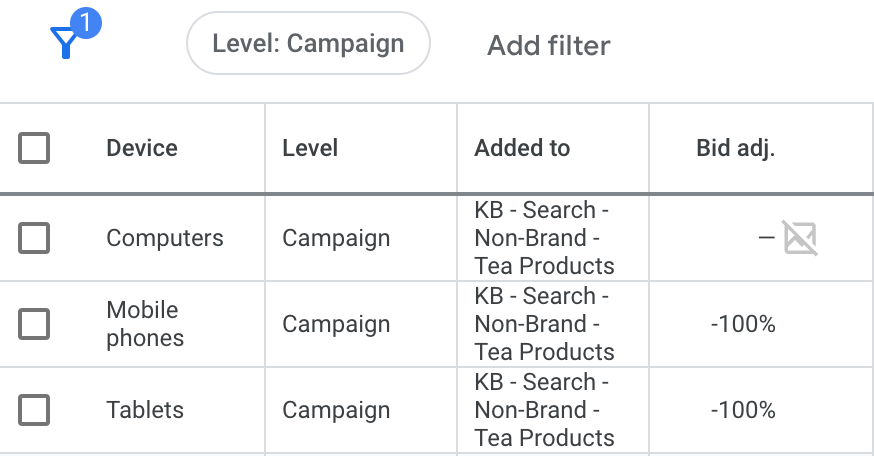
Next, you’ll copy the campaign you’ve just created and paste it twice. Your next campaign will have desktop and tablet set to -100%, followed by another with desktop and mobile set to -100%.
Be sure to update your naming conventions appropriately, and you now have Shopping campaigns segmented by device. Pretty simple, right?
5. Add remarketing lists to your campaigns (two techniques)
You may already know that Remarketing Lists for Search Ads (RLSAs) can help you maximize your conversions on the Search Network by letting you bid more aggressively for your highest-intent audiences.
But have you done the same for your Shopping campaigns?
There are two main approaches you can take to be smarter and more aggressive in the Shopping results at the same time:
- Observation audiences applied to all campaigns at the ad group level.
- Targeting audiences applied to an individual campaign.
Let’s break down the benefits of each strategy.
Observation audiences across campaigns
Observation audiences are a straightforward way to boost all of your Shopping campaigns with the power of audience data you’ve collected.
Observation audiences allow you to add audiences to your ad groups without narrowing down your targeting.
For example, if I add a pricing page visitors audience to my ad group on observation mode, that doesn’t mean my ad group’s only going to show ads to people in that audience. Essentially, you’re just observing how the data your ad group collects relates to the audiences you’ve applied.
But the nice thing is that you can set higher (or lower) bid adjustments on those audiences to prioritize (or de-prioritize) the traffic that comes from them.
To set these up, it’s a good idea to create and structure them in Google Analytics. This makes it so that you can create your audiences from micro conversions (e.g., page views, time on site) and macro conversions (e.g., purchases).
To create your remarketing audiences in Google Analytics, you’ll go into the Admin tab, then “Audience Definitions.”
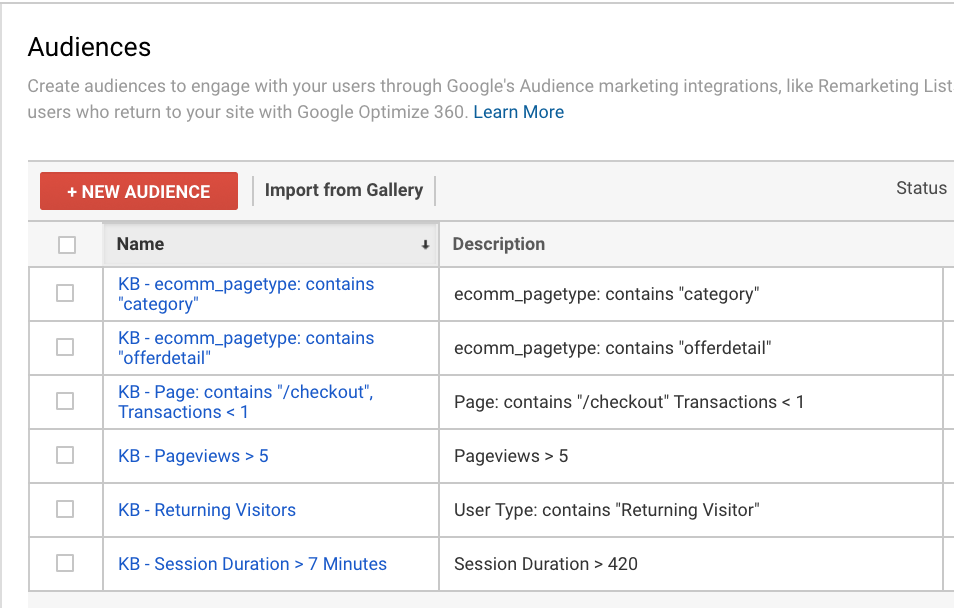
Tracking funnel progress to generate conversions
Typically, you’ll find that people who move further through the funnel tend to have a better rate of converting.
For example, someone who’s a shopping cart abandoner is still in the funnel. To get this person to convert while they’re still considering the purchase, you’d want to use an audience with a short duration, like seven days. You can also use a high bid modifier to ensure that your shopper doesn’t forget about you.
Someone who’s just been browsing, on the other hand, may have just been window shopping. To improve your chances of converting that kind of visitor, you’ll want to use a longer audience duration because this person may still be in more of a research than consideration stage.
Because this person isn’t worth as much as a shopping cart abandoner (or even a returning customer, depending on your business), you’ll also want to use a lower bid modifier.
The easiest way to add these audiences to all of your ad groups at once is through Google Ads Editor. Once you’re in Google Ads Editor, go to the bottom left pane, navigate to keywords and targeting, and then select Audiences.
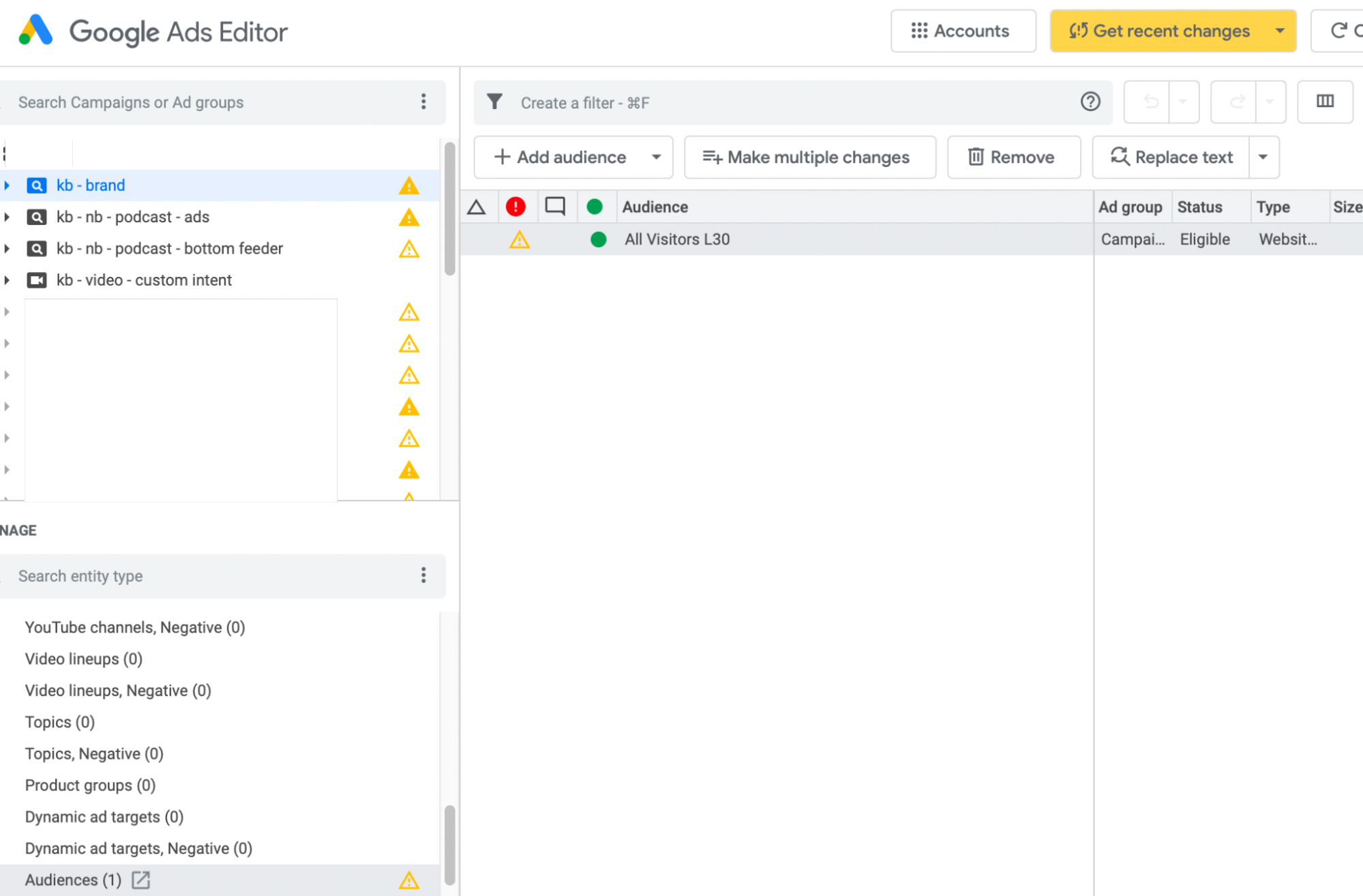
Because Shopping ads are still served to people on the Search Network, you’ll want to ensure that your audience has ‘cookied’ at least 1,000 search users. Otherwise, your audience won’t be usable on the Search Network.
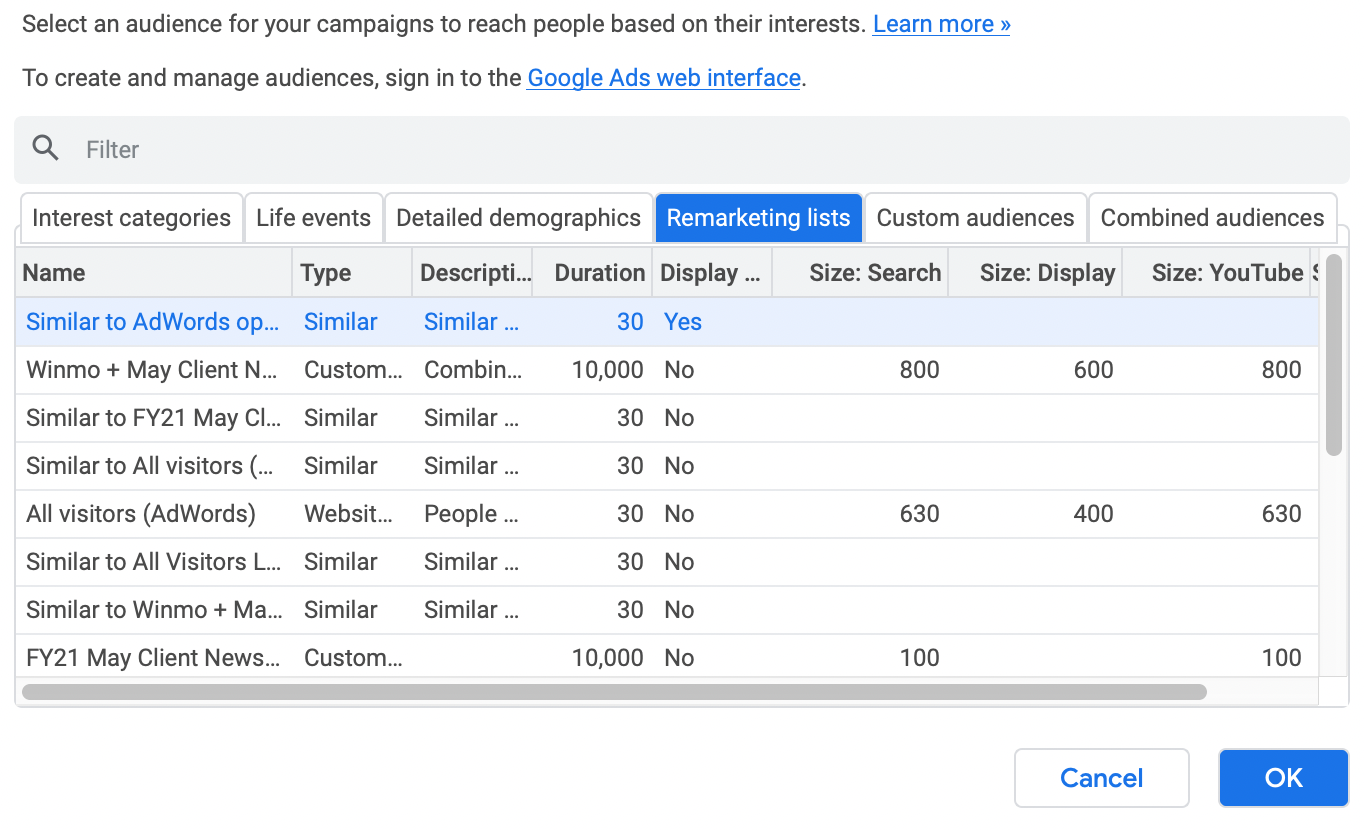
Flexible reach options
Now, there's one trick to make sure you don’t totally constrict the traffic of your observation Shopping campaign. You’ll notice these “flexible reach” options in the right-hand panel of the audience screen in Google Ads Editor.
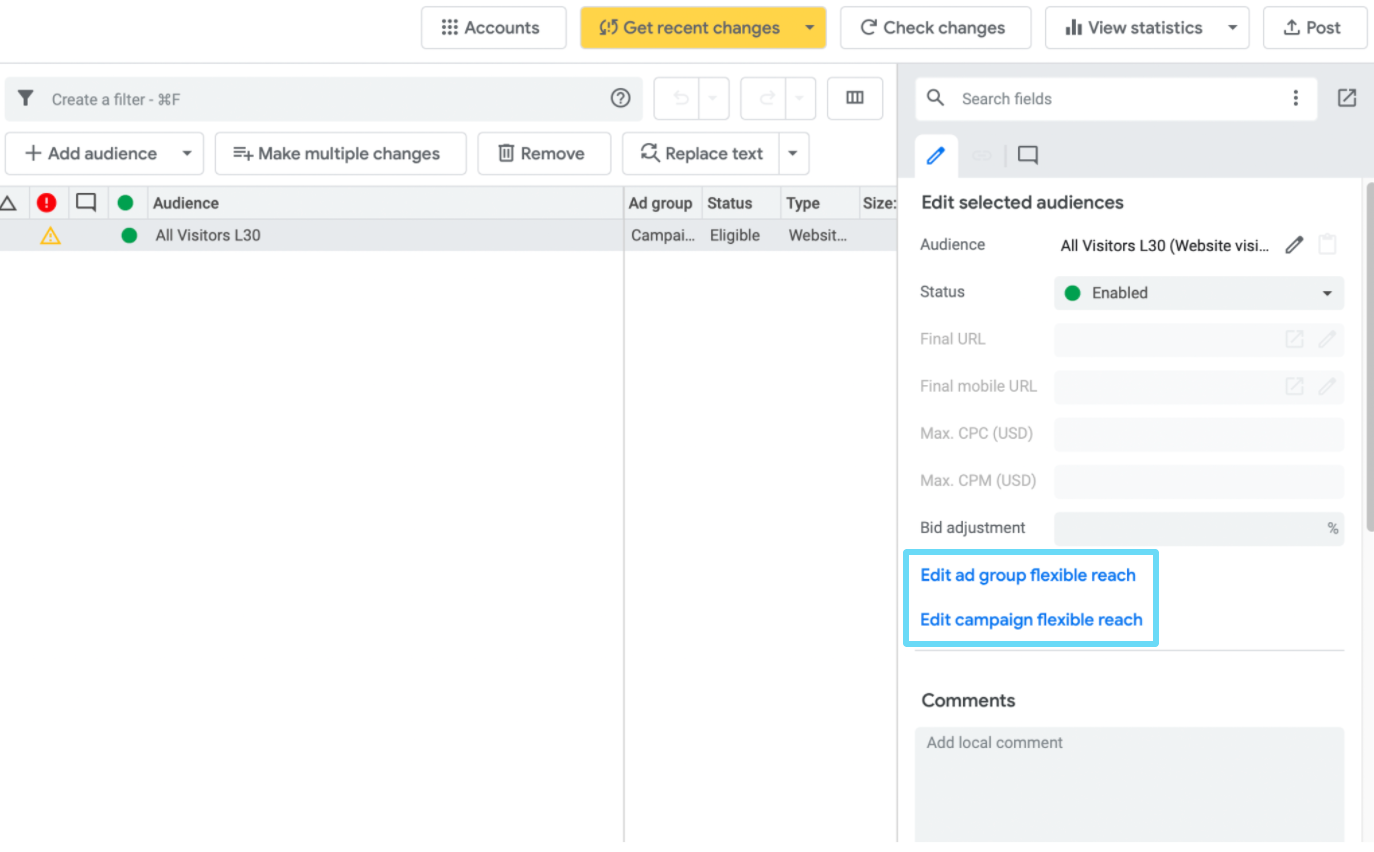
The flexible reach settings are what determine whether you want target audiences to observe and bid or whether you want target audiences to narrow your original targeting.
So, you’ll want to ensure that your ad group’s flexible reach for audiences is set to “Observation” in this case.
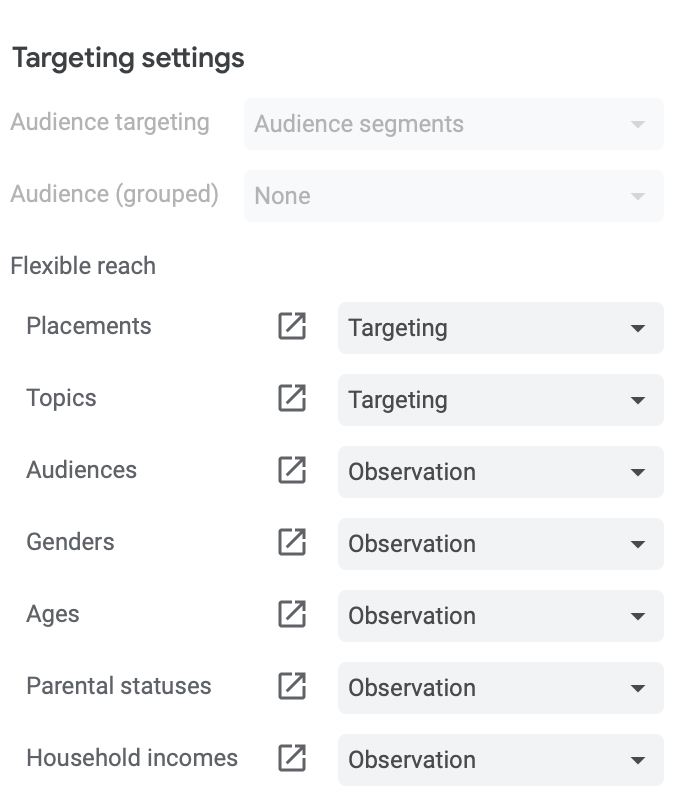
Targeting audiences across campaigns
What if you want to be more aggressive with upper-funnel searches?
Even if you sold shoes, such a basic search like “shoes” would probably be on your universal exclusion list. On the other hand, what if you could guarantee that a search like “shoes” would only be shown to people who’ve been to your website?
You already know that those people are more qualified than someone who’s never heard of you.
That’s where “Targeting” mode comes in.
You’ll need to set up a unique campaign to focus only on audience searches while the other(s) bring in new visitors. To distinguish this one from your other campaigns, you could append it with “RLSA.”
You’ll also want to be sure you still add your audiences at the ad group level, like in the previous example. This will provide more granular control over each of your audiences.
Because this campaign is focused exclusively on previous visitors, don’t be afraid to allow broader searches than normal. This is your chance to remind potential customers about you and convert them.
Google Shopping campaign optimization checklist
So, you’ve got your Google Shopping campaigns all set up. You’re probably thinking, “Now what?”
Even though setting up Google Shopping can be a challenge, arguably the bigger challenge is knowing what to do next with your campaigns.
How do you prevent performance slumps? Or, how do you repair performance slumps if they’ve already happened? How can you constantly be working to evolve your Shopping campaigns for better return on ad spend (ROAS)?
We’ve got you covered with a list of our top Google Shopping optimization tips that’ll help you continually make the most of your Shopping efforts.
Optimize your product feed for success
We’ve covered a lot of product feed requirements in this article, but what if I told you there was just one piece of data that stands above all the rest?
Search Engine Land tested a series of product feed optimizations that involved major changes to product descriptions, product categories, and product titles. The former two categories showed almost no difference in overall traffic volume. Improving or hampering attributes for relevance had no impact, like having a description of a baseball cap for a party dress.
Improving the relevance of the product title, on the other hand, led to a nearly 10x improvement in traffic volume.
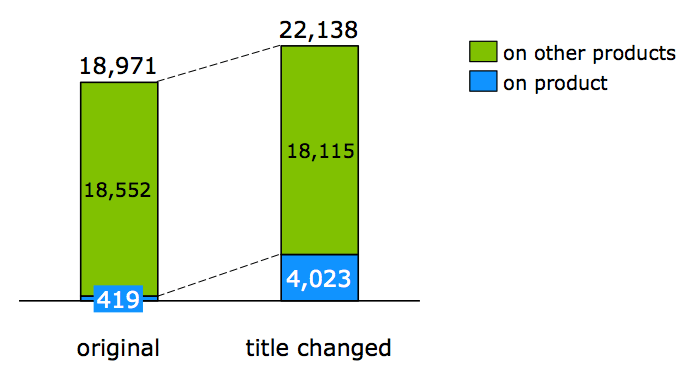
If you want to make optimizations in your product feed that will have a strong impact on your overall traffic, start with the product title. Don’t worry too much about optimizing areas that aren’t going to have as big a return on your time, such as product description and product category.
We’ve already covered a couple quick suggestions on product title building earlier on. But for a more thorough look at how to make your product titles winners, as well as tips to improve other areas of your feed, head to this article to brush up.
Use negative keywords to your advantage
If you’ve decided to run your Shopping campaigns with a SPAG structure, you can easily see what searches are triggering each of your products to show.
Inevitably, your products will turn up for searches that are irrelevant. It happens to every campaign, Shopping or otherwise.
The best way to tighten up your campaigns is by using the granularity of those SPAGs and their search terms to your benefit.
Of course, you can (and should) sweep for negative keywords if you’re not using SPAGs, too. You just won’t have the granularity to tell you which products are showing for which searches, which gives better insight into why some search terms are failing you.
Look through your search terms for each ad group and see what searches are getting clicks (AKA, spending money). Look for terms that are downright irrelevant, like someone searching for baby booties when your listing is for cowboy boots.
You’ll also want to keep an eye out for relevant terms that are getting a significant amount of clicks but no conversions (or very high CPAs) over a historical period of 30–60 days.
You can add search terms to your negative keywords by selecting them in the search terms report and clicking “Add as Negative Keyword” at the top of the list.
This can be done for multiple keywords at a time and is likely the most efficient way to exclude bad search terms. However, each search term you exclude this way will be excluded as an exact match negative keyword.
If you want to also exclude a phrase variant of this search term, for example, you can make your own list on the side and apply it at the ad group level in the negative keywords tab.
Nip vague queries in the bud
Unless your strategic intention for a certain campaign or certain ad groups is awareness-level exposure, you don’t want to waste money on queries that are too broad.
Someone searching for “boots” could want any kind of boot. If you’re selling cowboy boots…that’s a pretty specific end of the boot market.
A vague query like that could get you clicks, but they’re more likely to be from people who are hoping you might have other boots, or who just want to look and leave. Hence, a waste of money.
Or, that query might get you plenty of impressions, but low clicks, meaning a lower CTR.
A keyword like “boots” gets searched a lot. So even if it’s not resulting in clicks, Google’s investing a lot of time and effort throwing your Shopping ad out for that (highly competitive) query when it could be focusing more on showing your ad for specific queries with better intent.
Bottom line? You want your cowboy boots to be front and center for those searching “low heel cowboy boot” or “Ariat Circuit Wagner Western Boot.” Not someone who’s searching “boots” and is really looking for suede booties.
Adjust your product bids
Not all products are created equal…unfortunately. What we mean by that is you’ll probably have some products that perform like a well-oiled machine and some that consistently flunk.
Now, there are things you can do to try to fix your flunkers, like looking at your search terms report for a reason they’re not raking in the ROAS.
But while you’re doing your investigative work, it’s a good idea to put other measures in place to prevent those products from becoming a drain on your campaign.
If you’re using manual or ECPC bidding, you have the ability to adjust your product bids at the ad group level. This is your secret superpower.
Prioritize those products that sell well and bring in excellent ROAS by raising bids on them to remain competitive. De-prioritize those products that only seem to waste money by reducing bids on them.
Again, a SPAG structure gives you the granularity that allows your ad group bids to be your “product bids.” That is, each ad group contains one product, so your bid for that ad group is your bid for that product specifically.
If you’re using a condensed Shopping structure because your inventory is too large for SPAGs to make sense, you can still use this tactic on your ad groups. The difference is that you’ll be adjusting ad group bids that apply to groups of products whose performance altogether is better or worse.
So, while you may be able to tell which products are letting you down by viewing their metrics in your products tab, you won’t be able to influence your bidding on an individual product level unless you’ve structured with SPAGs.
Tinker with your bid adjustments
Google Search Ads bid adjustments are percentage increases to bids that can be applied to devices, audiences, ad schedules, geolocations, and demographics.
Whether you’re using SPAGs or not, bid adjustments are useful tools for any structure.
I often find that some devices perform better, and other devices tend to result in waste (tablets and TV screens, I’m looking at you).
It also makes sense that some of your targeted geolocations may perform better than others. For example, even if you sell cowboy boots nationwide, they might be more likely to sell better in Texas or Kentucky than in New York.
You get the picture.
So, look at each level where bid adjustments are available and see where you can make changes to bid more heavily on factors that perform the best and where you can bid lower.
As you may have gathered from our earlier discussion on device bidding, bid adjustments can be negative, too. So don’t be afraid to use a -100% bid adjustment on things that have only wasted money for months.
In other words, if tablets have spent $2,000 this month and $2,500 last month, but you’ve only gotten 1 conversion out of all that spend, slap a hefty negative bid adjustment on that device.
Exclude products that never perform
If you’ve been optimizing a handful of money-wasting products for a while but haven’t been able to get them to benefit you, it might be time to pull the plug on them.
As much as you want to see all your products leave the shelves (or warehouse), that doesn’t mean that spending ad dollars advertising all your products is a good investment.
Let’s face it: some of your products will be a big hit with your target customers, and some won’t. Sometimes, even a solid advertising strategy can’t change that.
Ultimately, you want to maximize performance from the products that do make you money. And one of the ways you can do so is by redirecting budget to the products that count.
If you have products that have been eager to spend your Shopping campaign dollars but that never seem to get sales—and you’ve done all you can think of to improve their performance already—consider excluding those products from your ad groups.
Check your search partner site performance
For non-Shopping campaigns, we tend to prefer keeping search partners enabled for better brand exposure. But enabling Search Partners won’t always benefit every situation.
One of the biggest benefits of Shopping campaigns is that Google’s showing your products for the searches it finds to be most relevant. People tend to be actively searching Google for items like yours to research or buy.
When your Shopping ads show on search partner sites, you’re still showing for queries made, but they’re made through the directories or search results pages of those sites. People might not have arrived or clicked the directory on those search partner sites to shop, so the intent is less clear.
For example, YouTube is considered a Search Partner site. Let’s say I searched for “cat litter reviews,” meaning I’m looking for videos from actual cat people that can show me how that litter performs on video.
That’s why I came to YouTube, you know…for videos. I’ve got to see how that clay clumps. But what I saw first were actually Google Shopping ads.
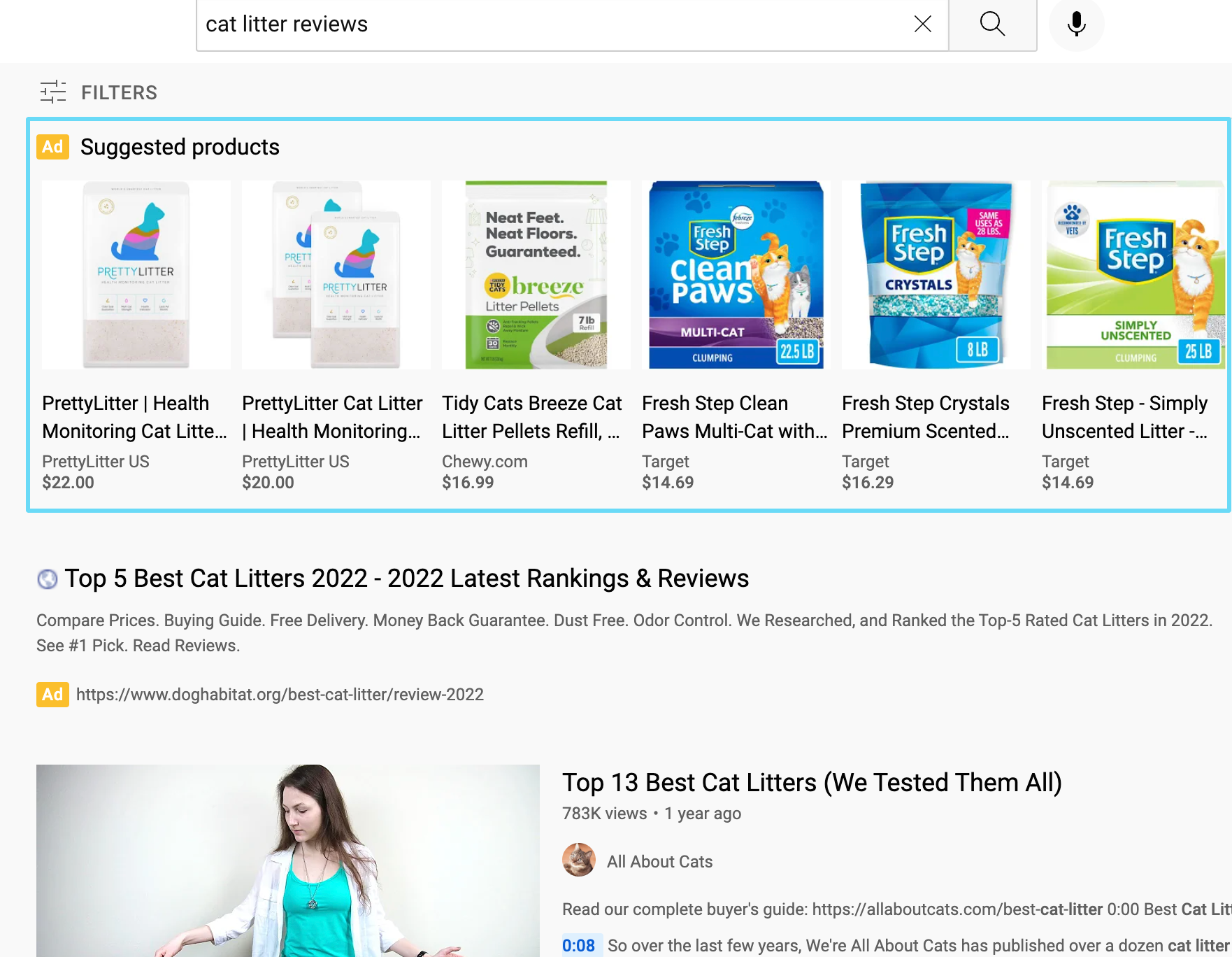
The intent of my YouTube search wasn’t to shop, and I especially didn’t gain anything that answered my question by looking at these Shopping ads.
So, you can see how this could be problematic.
In fact, a recent study showed that Google Shopping ads saw a 90% lower CTR on Search Partner sites than on Google search results.
Although CTR isn’t the main metric you should be chasing, lower overall CTR tends to lower your expected CTR, which results in poorer Quality Scores, and poorer ranking overall. The end result of this domino effect can be poorer conversion rates from all these factors combined.
And -90% is a big difference.
To check on how Search Partner sites perform versus Google search results, you can go to the campaign or ad group level and segment for “Network (with search partners).”
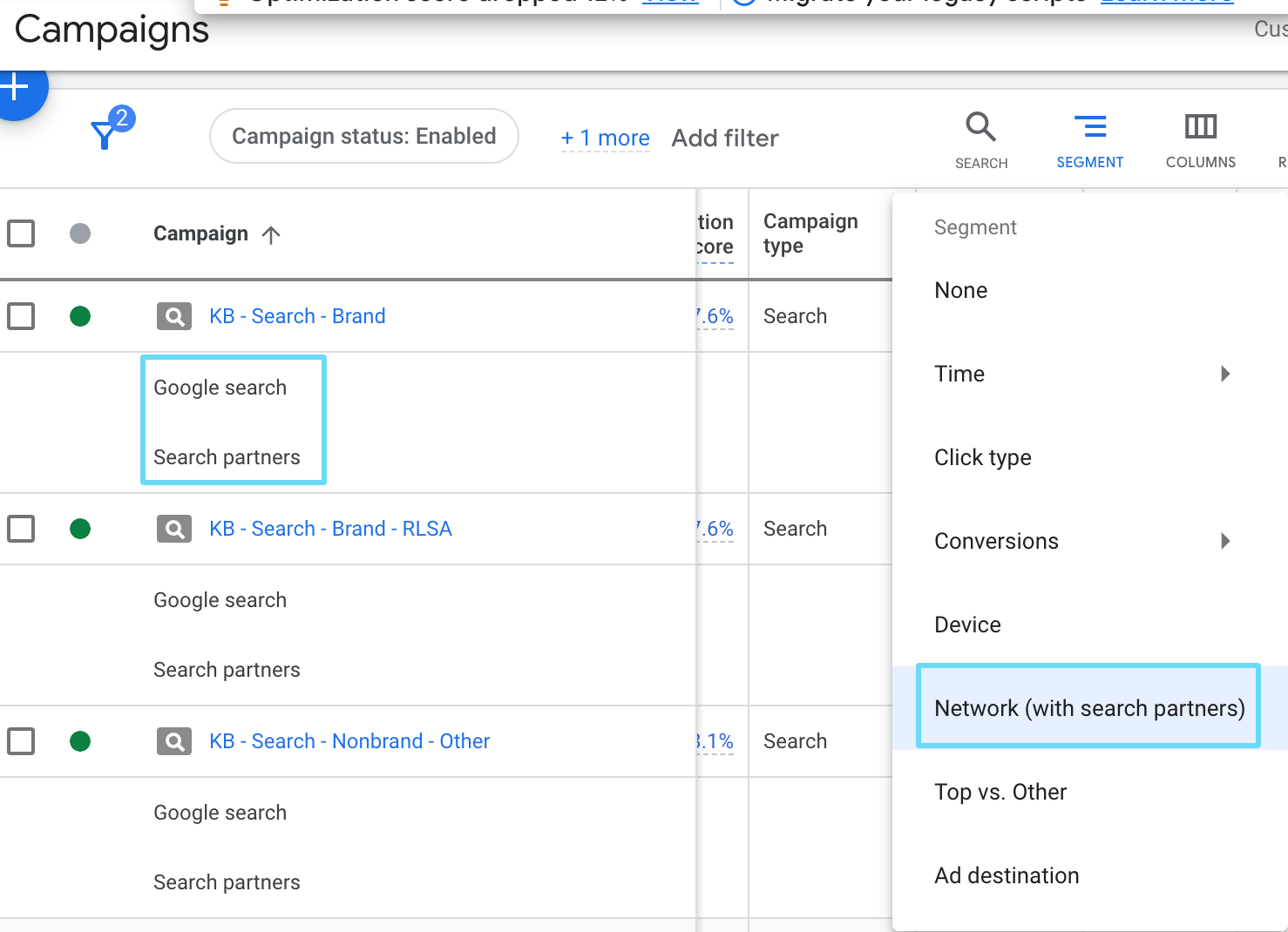
And if search partner sites just aren’t working out, then you can remove them by going to your campaign settings and unchecking the search partners box under “Networks.”
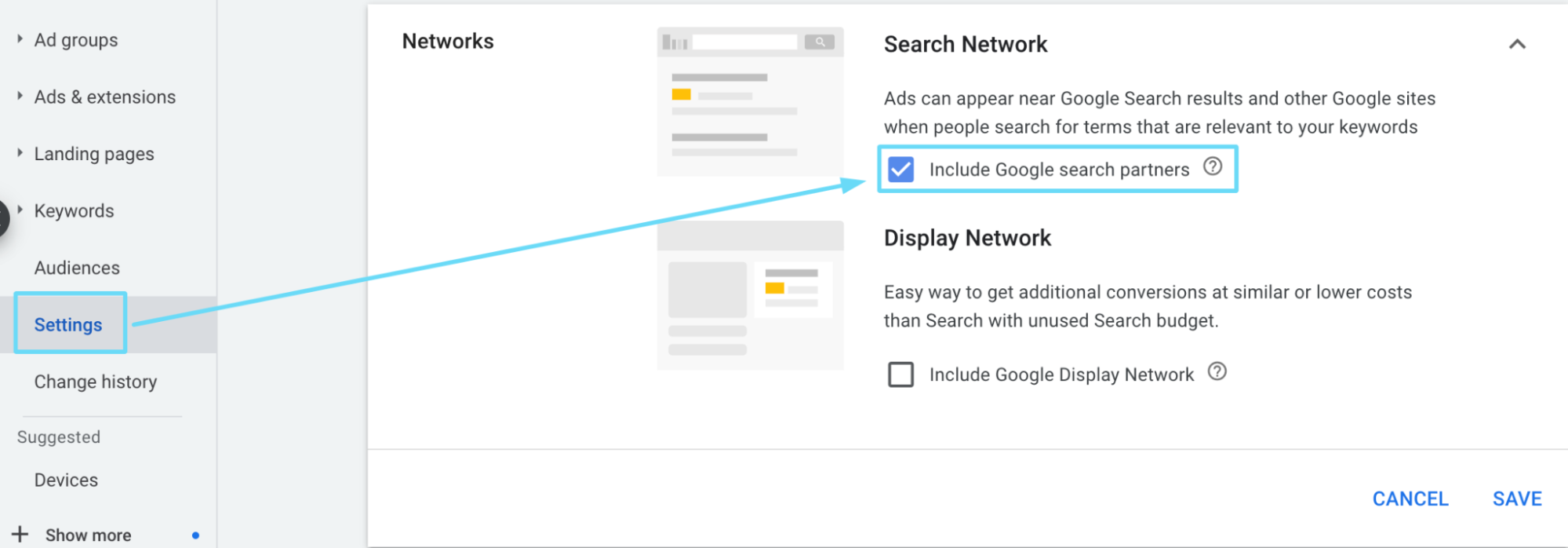
If you want the exposure that search partner sites bring to your brand even though they don’t perform, try keeping them enabled on awareness-focused campaigns only, and keep them out of your bottom-of-funnel efforts.
Wrapping up on Google Shopping campaigns
By now, you should be feeling some serious power when it comes to Google Shopping campaigns.
You’ve learned how to get your Shopping campaigns going from A–to–Z and how to keep them healthy with optimizations once they’re up and running.
Now that you’re about to graduate from this Google Shopping guide, remember these extra tips to keep your campaigns on an upward trajectory:
- Analyze your products on an individual level to see which ones are most profitable and which ones aren’t.
- Don’t set and forget your shopping structure, especially query-level bidding.
- Don’t place the same priority on all of your remarketing audiences—your bids and bid modifiers should relate in some way to how much purchase intent the audience has.
You’re also more than ready now to tackle the next step in your quest for Shopping campaign knowledge: Google Smart Shopping.